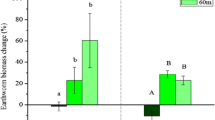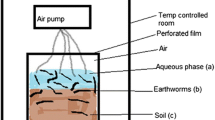Summary
The earthworm Lumbricus rubellus contained more Ca and Zn, and less Pb and Cd, than Dendrobaena rubida living in the same contaminated disused-mine soil. Differences in the kinetics of Ca turnover may account for some of the inter-specific differences in heavy metal burdens, although the calciferous glands do not seem to be directly involved in heavy metal excretion. A comparison of the present findings with published data indicated that the concentration of soil Ca and the bioavailability of heavy metals, both factors being allied to soil pH, are important exogenous determinants of heavy metal accumulation by different earthworm populations. Electron microprobe X-ray analysis of air-dried smears of chloragogenous tissue showed that the metals were fairly specifically compartmentalized into two distinct organelles in both worms: Ca, Pb and Zn were found (associated with P) in the chloragosomes; Cd was found (with S and probably in stoichiometric association) in a more electron-lucent vesicular component, designated the ‘cadmosome’, but which may be identical with the debris vesicles which are characteristic inclusions in conventionally-fixed chloragocytes. The in vivo incorporation of Pb by the chloragosomes of D. rubida was accompanied by the loss of Ca, Zn and P.
Similar content being viewed by others
References
Appleton TC (1978) The contribution of cryoultramicrotomy to X-ray microanalysis in biology. In: Erasmus DA (ed) Electron probe microanalysis in biology. Chapman and Hall, London, pp 148–182
Ash CPJ, Lee DL (1980) Lead, cadmium, copper and iron in earthworms from roadside sites. Environ Pollut 22:59–67
Chandler JA, Battersby S (1976) X-ray microanalysis of ultrathin frozen and freeze dried sections of human sperm cells. J Microsc 107:55–65
Cooke M, Jackson A, Nickless G, Roberts DJ (1979) Distribution and speciation of cadmium in the terrestrial snail, Helix aspersa. Bull Environ Contam Toxicol 23:445–451
Coombs TL, George SG (1977) Mechanisms of immobilization and detoxication of metals in marine organisms. In: Mclusky DS, Berry AJ (eds) Physiology and behaviour of marine organisms. Pergamon Press, Oxford, pp 179–187
Davies BE (1980) Trace element pollution. In: Davies BE (ed) Applied soil trace elements. John Wiley and Sons, Chichester, New York, Brisbane, Toronto, pp 287–351
Fischer E, Trombitas K (1980) X-ray microprobe analysis of chloragosomes of untreated and of EDTA-treated Lumbricus terrestris by using fresh air-dried smears. Acta Histochem 66:237–242
Foster P (1976) Concentration and concentration factors of heavy metals in brown algae. Environ Pollut 10:45–54
George SG, Nott JA, Pirie BJS, Mason AZ (1976) A comparative quantitative study of cadmium retention in tissues of a marine bivalve during different fixation and embedding procedures. Proc R Microsc Soc II (Micro'76 Suppl), p 42
George SG, Pirie BJS, Cheyne AR, Coombs TL, Grant PT (1978) Detoxication of metals by marine bivalves: an ultrastructural study of the compartmentation of copper and zinc in the oyster Ostrea edulis. Mar Biol 45:147–156
George SG, Pirie BJS (1979) The occurrence of cadmium in subcellular particles, in the kidney of the marine mussel, Mytilus edulis, exposed to cadmium. Biochim Biophys Acta 580:234–244
George SG, Carpene E, Coombs TL, Overnell J, Youngson A (1979) Characterization of cadmium-binding proteins from mussels, Mytilus edulis (L), exposed to cadmium. Biochim Biophys Acta 580:225–233
Gish CD, Christensen RE (1973) Cadmium, nickel, lead and zinc in earthworms from roadside soil. Environ Sci Technol 7:1060–1062
Gullvag BM (1978) Metal measured in earthworm tissue by X-ray microanalysis. In: Sturgess JM (ed) Electron microscopy 1978, Vol. 2: Biology. Microscopical Society of Canada, Toronto, pp 114–115
Howard AG, Nickless G (1975) Protein binding of cadmium, zinc and copper in environmentally insulated limpets, Patella vulgata. J Chromat 104:457–459
Howard AG, Nickless G (1977) Heavy metal complexation in polluted molluscs. I. Limpets (Patella vulgata and Patella intermedia). Chem Biol Interact 16:107–114
Hsu FS, Krook L, Pond WG, Duncan JR (1975) Interactions of dietary calcium with toxic levels of lead and zinc in pigs. J Nutr 105:112–118
Icely JD, Nott JA (1980) Accumulation of copper within the hepatopancreatic caeca of Corophium volutator (Crustacea: Amphipoda). Mar Biol 57:193–199
Ireland MP (1975a) Metal content of Dendrobaena rubida (Oligochaeta) in a base metal mining area. Oikos 26:74–79
Ireland MP (1975b) Distribution of lead, zinc and calcium in Dendrobaena rubida (Oligochaeta) living in soil contaminated by base metal mining in Wales. Comp Biochem Physiol 52 B:551–555
Ireland MP (1978) Heavy metal binding properties of earthworm chloragosomes. Acta Biol Hung 29:385–394
Ireland MP (1979) Metal accumulation by the earthworms Lumbricus rubellus, Dendrobaena veneta and Eiseniella tetraedra living in heavy metal polluted sites. Environ Pollut 19:201–206
Ireland MP (1981a) Uptake and distribution of cadmium in the slug Arion ater (L.). Comp Biochem Physiol 68 A:37–41
Ireland MP (1981 b) Earthworms and heavy metals. In: The Proceedings of the Darwin Centenary Symposium on Earthworm Ecology, Sept. 1981. Pedobiologia (In press)
Ireland MP, Richards KS (1977) The occurrence and localization of heavy metals and glycogen in the earthworms Lumbricus rubellus and Dendrobaena rubida from a heavy metal site. Histochemistry 51:153–166
Ireland MP, Richards KS (1981) Metal content, after exposure to cadmium, of two species of earthworms of known differing calcium metabolic activity. Environ Pollut 26:69–78
Ireland MP, Wooton RJ (1976) Variations in the lead, zinc and calcium content of Dendrobaena rubida (Oligochaeta) in a base metal mining area. Environ Pollut 10:201–208
Jarvis SC, Jones LHP, Hopper MJ (1976) Cadmium uptake from solution by plants and its transport from roots to shoots. Plant Soil 44:179–191
John MK (1976) Inter-relationships between plant cadmium and uptake of some other elements from culture solutions by oats and lettuce. Environ Pollut 11:85–95
Kojima Y, Kagi JHR (1978) Metallothionein. Trends Biochem Sci 3:90–93
Korte NE, Skopp J, Fuller WH, Niebla EE, Alesii BA (1976) Trace element movement in soils: influence of soil physical and chemical properties. Soil Sci 122:350–359
Martin MH, Coughtrey PJ (1975) Preliminary observations on the levels of cadmium in a contaminated environment. Chemosphere 3:155–160
Martin MH, Coughtrey PJ (1976) Comparisons between the levels of lead and cadmium within a contaminated environment. Chemosphere 5:15–20
Morgan AJ (1979) Non-freezing techniques for preparing biological specimens for electron microprobe X-ray microanalysis. In: Johari O (ed) Scanning electron microscopy 1979, Vol. 2, SEM Inc., AMF O'Hare, Illinois, pp 635–648
Morgan AJ (1980) Preparation of specimens. Changes in chemical integrity. In: Hayat MA (ed) X-ray microanalysis in biology. University Park Press, Baltimore, pp 65–165
Morgan AJ (1981) A morphological and electron microprobe study of the inorganic composition of the mineralized secretory products of the calciferous gland and chloragogenous tissue of the earthworm, Lumbricus terrestris L. The distribution of injected strontium. Cell Tissue Res 220:829–844
Morgan AJ, Davies TW, Erasmus DA (1978) Specimen preparation. In: Erasmus DA (ed) Electron probe microanalysis in biology. Chapman and Hall, London, pp 94–147
Morgan AJ, Winters C (1982) The elemental composition of the chloragosomes of two earth-worm species (Lumbricus terrestris and Allolobophora longa) determined by electron probe X-ray microanalysis of freeze-dried cryosections. Histochemistry 73:589–598
Noel-Lambot F (1976) Distribution of cadmium, zinc and copper in the mussel, Mytilus edulis. Existence of cadmium binding proteins similar to metallothioneins. Experientia 32:324–326
Olafson RW, Sim RG, Kearns A (1979) Physiological and chemical characterization of invertebrate metallotheionein-like porteins. In: Kagi JHR, Nordberg M (eds) Metallotheionein, Birkhäuser Verlag, Basel, Boston, Stuttgart, pp 197–204
Piearce TF (1972) The calcium relations of selected Lumbricidae. J Anim Ecol 41:167–188
Prentø P (1979) Metals and phosphate in the chloragosomes of Lumbricus terrestris and their possible physiological significance. Cell Tissue Res 196:123–134
Probst GS (1979) Cadmium: absorption, distribution and excretion in mammals. In: Mennear JH (ed) Cadmium toxicity. Marcel Dekker, New York Basel, pp 29–59
Simkiss K (1976) Intracellular and extracellular routes of biomineralization. In: Calcium in biological systems, SEB Symposia No. 30. Cambridge University Press, Cambridge, pp 423–444
Singhal RL, Merali Z (1979) Biochemical toxicity of cadmium. In: Mennear JH (ed) Cadmium toxicity. Marcel Dekker, New York Basel pp 61–112
Suzuki KT, Takenaka S, Kubota K (1979) Fate and comparative toxicity of metallothioneins with differing Cd/Zn ratios in rat kidney. Arch Environ Contam Toxicol 8:85–95
Tuck NW, Tuck JP (1971) Roman mine, Draethen, Glamorganshire. Bristol Exploration Club, Caving Report No, 15
Van Hook RI (1974) Cadmium, lead and zinc distribution between earthworms and soils. Potential for biological accumulation. Bull Environ Contam Toxicol 12:509–513
Walker G (1977) “Copper” granules in the barnacle Balanus balanoides. Mar Biol 39:343–349
Weser U, Rupp H (1979) Copper-thionein and other metal — sulphur — proteins. In: Kagi JHR, Nordberg M (eds) Metallothionein. Birkhäuser Verlag, Basel Boston Stuttgart pp 221–230
Wielgus-Serafinska E, Kawka E (1976) Accumulation and localization of lead in Eisenia foetida (Oligochaeta) tissue. Folia Histochem Cytochem 14:315–320
Williams AF (1981) Metal metabolism in earthworms. Unpublished M.Sc. thesis, University of Wales
Wright MA, Stringer A (1980) Lead, zinc and cadmium content of earthworms from pasture in the vicinity of an industrial smelting complex. Environ Pollut 23:313–321
Author information
Authors and Affiliations
Rights and permissions
About this article
Cite this article
Morgan, A.J., Morris, B. The accumulation and intracellular compartmentation of cadmium, lead, zinc and calcium in two earthworm species (Dendrobaena rubida and Lumbricus rubellus) living in highly contaminated soil. Histochemistry 75, 269–285 (1982). https://doi.org/10.1007/BF00496017
Received:
Issue Date:
DOI: https://doi.org/10.1007/BF00496017




